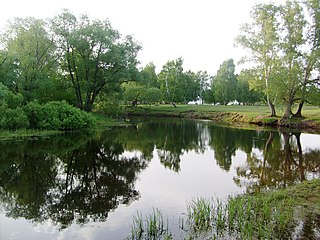
The Tobol is a river in Western Siberia and the main (left) tributary of the Irtysh. Its length is 1,591 km (989 mi), and the area of its drainage basin is 426,000 km2 (164,000 sq mi).
Krubera Cave is the second-deepest-known cave on Earth, after the Veryovkina Cave. It is located in the Arabika Massif of the Gagra Range of the Western Caucasus, in the Gagra District of Abkhazia, a partly recognised state, previously part of Soviet Georgia.

The Šešupė ; Russian: Шешупе; German: Scheschup(p)e; Polish: Szeszupa) is a 298 km long river that flows through Poland (27 km), Lithuania (158 km), and Russia (62 km). The river flows for 51 km along the border between the Kaliningrad Oblast, an exclave of Russia, and Lithuania. The Šešupė originates near the Polish town of Szeszupka, about 16 km from the Polish-Lithuanian border, and flows into the Nemunas near the town of Neman on the border between Lithuania and Kaliningrad Oblast.

Lake Lovozero is located on the Kola Peninsula, in Murmansk Oblast within the Barents Sea basin and ensures runoff from the river Voronya. Area: 200 km², average depth is 5.7 metres, maximal 35 m. Annual fluctuations do not exceed 1 m, and the average period of water renewal is about 10 months. The lake has a winding coastline and many peninsulas and islands. The area surrounding the lake, e.g. the Lovozerskiye Tundras is commonly known as "Ловозёрье" in Russian.
Voronya is a river in the Kola Peninsula in Murmansk Oblast, Russia.

The Seym or Seim is a river that flows westward in Russia and Ukraine. It is 748 kilometres (465 mi) long and its basin area about 27,500 square kilometres (10,600 sq mi). It is the largest tributary of the Desna.

Arabika Massif (Arabika) is a glacially eroded karst outcropping of the Gagra Range, Abkhazia, Georgia in the West Caucasus, by the city of Gagra. The highest elevation - mountain Arabika is 2,656 metres (8,714 ft).

The New Athos Cave also Novoafonskaya, Novy Afon Cave, or New Afon Cave is a karst cave in the Iverian Mountain in Abkhazia (Georgia) near the city of New Athos.

Duderhof Heights or Duderhof Hills is a small highland area in the southwestern part of Saint Petersburg.

Lake Chudzyavr is a large freshwater lake on the Kola Peninsula in Murmansk Oblast, Russia. It has an area of 57.8 square kilometers (22.3 sq mi). The river Chudzyok flows from the lake.

The Razdolnaya or Suifen is a river in People's Republic of China and Russia. It flows into the Amur Bay of the Sea of Japan.

Tumanny is an urban locality in Kolsky District of Murmansk Oblast, Russia, located on the Kola Peninsula on the lower Voronya River, 96 kilometers (60 mi) east of Murmansk. Population: 685 (2010 Census); 950 (2002 Census); 1,918 (1989 Soviet census).

The Samur is a river in Russia's Dagestan Republic, also partially flowing through Azerbaijan and forming part of the Azerbaijan–Russia border.
Vorona is a monotypic genus of prehistoric birds.

The Murman Coast is a coastal area in Murmansk Oblast in northwest Russia. It is located on the southern side of the Barents Sea, between the Norway–Russia border and Cape Svyatoy Nos. The major rivers flowing to the sea at the coast are the Tuloma and the Voronya.

Jurij Mihajlovič Kasjan is a Ukrainian speleologist, most known for his work in cave exploration, especially as the Call of the Abyss research project coordinator. He was heading the speleological expeditions to caves of the Arabika massif in Abkhazia and, with Aleksandr Klimčuk, to Aladaglar massif in Turkey. Some of the world's deepest caves were explored, including the first cave, deeper than 2,000 m, the Krubera-Voronja Cave.

Pavel Yevgenyevich Demidov was a Russian speleologist, most known for his work in extreme cave exploration, especially as the leader of the Perovo-speleo team expeditions to Veryovkina Cave on Arabika massif in Abkhazia, from 2017 the deepest cave in the world.

The Burla is a river in Russia and Kazakhstan. It is 489 kilometres (304 mi) long and has a catchment area of 12,800 square kilometres (4,900 sq mi).
















